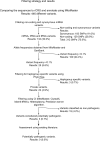Private mitochondrial DNA variants in danish patients with hypertrophic cardiomyopathy
- PMID: 25923817
- PMCID: PMC4414448
- DOI: 10.1371/journal.pone.0124540
Private mitochondrial DNA variants in danish patients with hypertrophic cardiomyopathy
Abstract
Hypertrophic cardiomyopathy (HCM) is a genetic cardiac disease primarily caused by mutations in genes coding for sarcomeric proteins. A molecular-genetic etiology can be established in ~60% of cases. Evolutionarily conserved mitochondrial DNA (mtDNA) haplogroups are susceptibility factors for HCM. Several polymorphic mtDNA variants are associated with a variety of late-onset degenerative diseases and affect mitochondrial function. We examined the role of private, non-haplogroup associated, mitochondrial variants in the etiology of HCM. In 87 Danish HCM patients, full mtDNA sequencing revealed 446 variants. After elimination of 312 (69.9%) non-coding and synonymous variants, a further 109 (24.4%) with a global prevalence > 0.1%, three (0.7%) haplogroup associated and 19 (2.0%) variants with a low predicted in silico likelihood of pathogenicity, three variants: MT-TC: m.5772G>A, MT-TF: m.644A>G, and MT-CYB: m.15024G>A, p.C93Y remained. A detailed analysis of these variants indicated that none of them are likely to cause HCM. In conclusion, private mtDNA mutations are frequent, but they are rarely, if ever, associated with HCM.
Conflict of interest statement
Figures
References
-
- Maron BJ, Towbin JA, Thiene G, Antzelevitch C, Corrado D, Arnett D, et al. Contemporary definitions and classification of the cardiomyopathies: an American Heart Association Scientific Statement from the Council on Clinical Cardiology, Heart Failure and Transplantation Committee; Quality of Care and Outcomes Research and Functional Genomics and Translational Biology Interdisciplinary Working Groups; and Council on Epidemiology and Prevention. Circulation 2006; 113: 1807–1816. - PubMed
Publication types
MeSH terms
Substances
LinkOut - more resources
Full Text Sources
Other Literature Sources
Miscellaneous


